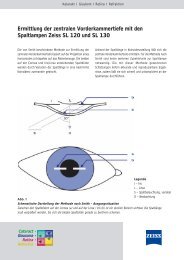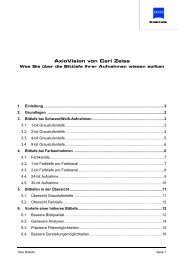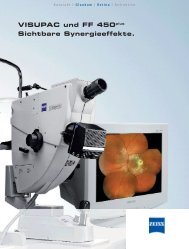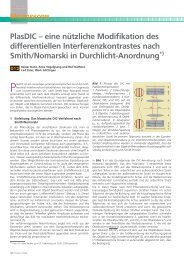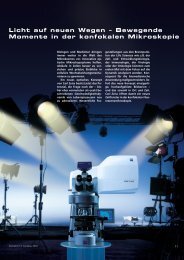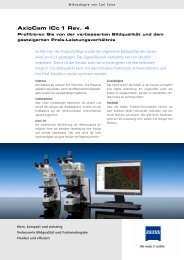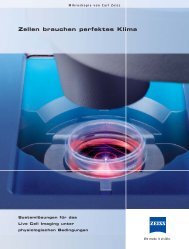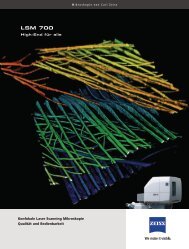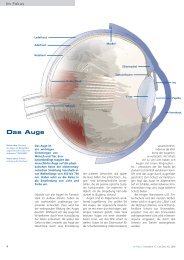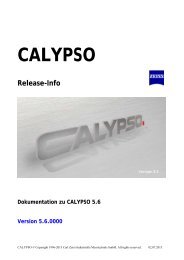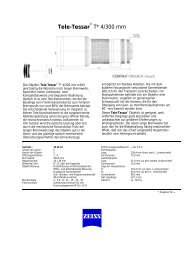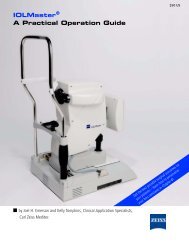FEMTO-LASIK and BEYOND - Carl Zeiss, Inc.
FEMTO-LASIK and BEYOND - Carl Zeiss, Inc.
FEMTO-LASIK and BEYOND - Carl Zeiss, Inc.
You also want an ePaper? Increase the reach of your titles
YUMPU automatically turns print PDFs into web optimized ePapers that Google loves.
June 2012 Supplement<br />
7<br />
we normally use an S cone if it is a 12-2 or 12-3 mm<br />
cornea. With an M cone, it is a little easier to get suction<br />
breaks,” she said.<br />
VisuMax vs IntraLase <strong>LASIK</strong>: She discussed the retrospective,<br />
multi-surgeon study of <strong>LASIK</strong> performed for myopia<br />
with or without astigmatism from September 2009 to<br />
April 2010 at SNEC. According to her, the efficacy index,<br />
predictability <strong>and</strong> safety were similar for VisuMax (n=882)<br />
<strong>and</strong> IntraLase (n=654). The VisuMax seemed to be much<br />
better in high myopes (-10D or more) with an efficacy index<br />
of 0.97 (n=8) as against the IntraLase with an efficacy<br />
index of 0.84 (n=9). “But the numbers are small <strong>and</strong> we<br />
may have confounded the results,” she cautioned.<br />
VisuMax vs IntraLase, Contralateral Eye Study: The<br />
prospective r<strong>and</strong>omized study consisted of a bilateral<br />
simultaneous <strong>LASIK</strong> with VisuMax 500 kHz femtosecond<br />
laser for <strong>LASIK</strong> flap creation in one eye <strong>and</strong> IntraLase<br />
femtosecond system in the fellow eye. Excimer laser<br />
ablation was done with Wavelight® Allegretto 400 kHz<br />
in both eyes. The patients <strong>and</strong> surgeons were interviewed<br />
perioperatively with a st<strong>and</strong>ardized questionnaire<br />
about their operative experiences <strong>and</strong> preferences. Dr<br />
Chan shared the results of 24 patients of the 40 target<br />
population. Despite of the VisuMax being a low pressure<br />
system, 17% had a loss of light perception during suction<br />
<strong>and</strong> during the femtosecond pass. The same was seen<br />
in around 45% with IntraLase. When questioned about<br />
the fear factor, 46% of the VisuMax patients <strong>and</strong> 67% of<br />
IntraLase patients were frightened during vacuum suction<br />
or applanation. “Most patients said that the vacuum<br />
suction for both the systems was the most painful part.<br />
The pain score for VisuMax was 1.7 <strong>and</strong> for IntraLase<br />
was much higher (4.3),” she said. Seventy-five percent<br />
<strong>and</strong> 2% of patients preferred the VisuMax <strong>and</strong> IntraLase,<br />
respectively. The patients disliked the discomfort <strong>and</strong> pain<br />
in IntraLase <strong>and</strong> the constant stare at green light in the<br />
VisuMax. According to Dr Chan, she finds the VisuMax<br />
to be “an easier platform” with lesser subconjunctival<br />
hemorrhage <strong>and</strong> suction loss. “About 45% of us felt that<br />
the IntraLase was easier to lift, 17% found VisuMax was<br />
easier to lift <strong>and</strong> 37% are had no preference,” she said.<br />
Conclusions: Dr Chan concluded that a nice <strong>and</strong> assuring<br />
upward trend in predictability has been obtained with the<br />
VisuMax. She feels that the VisuMax is also a preferred<br />
choice by patients. Loss of light perception occurred more<br />
frequently with the IntraLase during flap creation. “Since<br />
its inception in November 2008, SNEC has developed<br />
successful Femto-<strong>LASIK</strong> with VisuMax program. Good<br />
clinical outcomes for myopic <strong>LASIK</strong> have been achieved<br />
with excellent safety, predictability <strong>and</strong> efficacy profiles,”<br />
she summarized.<br />
Dr Patrick Versace on “Registration,<br />
Alignment <strong>and</strong> Tracking”<br />
“ZEISS provides us with a platform<br />
that effectively has three elements of<br />
a laser delivery system. It has good<br />
diagnostic, so we can measure corneal<br />
shape, we can measure the wavefront<br />
of the cornea <strong>and</strong> total eye, <strong>and</strong> these<br />
things are integrated into the<br />
CRS-Master. We can plan treatments<br />
integrating all the data that we collect.”<br />
Ablation, rotational alignment <strong>and</strong> tracking: “<strong>Zeiss</strong><br />
system tracks both the pupil <strong>and</strong> the limbus. It has<br />
a sampling speed <strong>and</strong> a response time,” Dr Versace<br />
said. He showed the impact of change in tracking speed on<br />
various parameters.<br />
Dr Versace specified how it was important to “put the ablation<br />
where it is meant to be on the cornea <strong>and</strong> to maintain<br />
that position throughout the treatment.” He agreed that<br />
success was in “having the device placed on the visual axis<br />
not on the pupil center.”<br />
Talking about an acceptable misalignment he said that a<br />
translational error of 300 μm to 400 μm <strong>and</strong> a rotational<br />
error of 8-10 degrees would still give a 50% reduction in<br />
higher order aberrations. He said that a workable registration<br />
would be an XY shift of less than 200 μm <strong>and</strong> a<br />
rotational alignment within 5 degrees. He then spoke about<br />
the wavefront alignment with the Zernicke reference <strong>and</strong><br />
how the pupil was used for wavefront capture. According<br />
to him, the ZEISS system does compensate for the shift in<br />
center of the pupil as the pupil dilates or gets smaller. “The<br />
ZEISS platform has a resolution of 100 μm with pupil<br />
center shift. That is well within what we need.”<br />
Angle kappa: Describing how a large angle kappa leads<br />
to a significant induction of coma, he shared the results<br />
for angle kappa from a recent study done in Iraq which<br />
unleashed that the angle kappa was common <strong>and</strong> the values<br />
were pretty much the same for all refractive errors, myopia<br />
<strong>and</strong> hyperopia.<br />
Cyclorotation: Referring to rotational alignment <strong>and</strong> astigmatism,<br />
Dr Versace spoke about “how much cyclorotation<br />
occurs when the patient goes from sitting to lying down.”<br />
“Most patients have less than 5 degrees cyclorotation,” he<br />
said. Dr Versace showed the WASCA/CRS-Master/MEL 80



